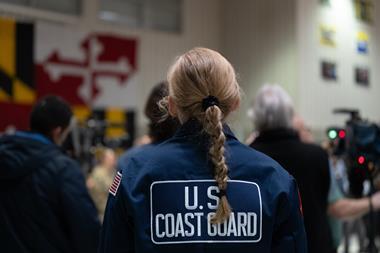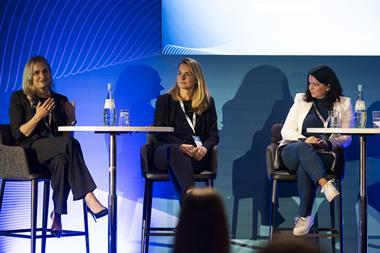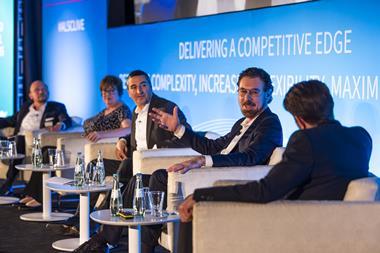The inaugural Import Export North America conference, a joint AIAG and Finished Vehicle Logistics event, saw executives and lawmakers debate how best to prepare the region to meet the logistics challenges of changing import and export flows and rising production. Executives gathered at the port of Baltimore, Maryland

“There are a lot of unanswered questions on things like Mexico,” said Scott Goodwin, senior manager for transportation at the Volkswagen Group of America. “The network has changed dramatically. I don’t think we have enough railcars.”
“I think that some of what we’ve been seeing this past year will be part of a ‘new normal’,” said Christine Krathwohl, managing director of the strategic advisory board at Jack Cooper Holdings, the continent’s largest car haulier. “There is a perfect storm hitting us with record sales, extreme weather – including the ‘polar vortex’ we experienced last winter that is forecasted to return – and legislation that impacts trucking.”
Despite these looming issues, the news has mainly been good for the region’s vehicle logistics players. US and Mexican production has been on the rise, satisfying strong local demand as well as growing exports within NAFTA and beyond it. According to Brandon Mason, senior analyst for the Americas at PwC Autofacts, production across the US, Canada and Mexico will grow to 16.9m this year from 16.2m in 2014; PwC forecasts that production will rise to 19.3m by 2020.
The event’s opening speaker, Paul Jaenichen, the Maritime Administrator at the US Department of Transportation (DOT), highlighted the growing global trade of vehicles and through US ports. He pointed out that global seaborne car trade has grown from around 13.4m vehicles in 2009 following the global crash to 21m units in 2013. The expectations for 2014 are for growth of about 5%, which would approach the ro-ro sector’s 2007-2008 highs.
For the US, new vehicle trade has already surpassed pre-recession levels, reaching 10m metric tonnes in 2013 and $38 billion across about 40 ports, with just over 6m tonnes of imports and just under 4m tonnes of exports. “There is growing demand for US-manufactured vehicles in Asia and Europe and perhaps in South America, so there is potential for more growth. We’ve got work to do to make sure that our port capacity is maintained and adequate for what is coming,” said Jaenichen.
Over the long term, Jaenichen pointed to dramatic expansion, with the expectation that the US population will expand by 80m people by 2050, bringing as much as a 50% increase in international trade. “We need to be prepared for that, which is why this administration is so focused on ports,” he said.
Changing patterns

With more Japanese and German brands currently expanding capacity in the US and especially in Mexico, the import share as a percentage of the market has been declining, from a high of 26% in 2009 to 22% currently said Mason, point to official US trade data. He expects that imports will level off or decline to around 3m units by 2020, or about 17.5% of US sales.
However, some of that decline masks a switch to imports from Mexico, volume that requires more rail and short-sea transport. Carmakers have been looking at new export routes from Mexico to the US, with Nissan, Ford, Honda, GM and Mazda all adding short sea routes to supplement traditional rail flows.
The shifts to Mexico, as well as other import and export developments, have led some manufacturers to either adjust their port network or enhance the services they use there. Honda and Nissan have recently added port calls to their network, for example. According to Scott Pollard, manager of vehicle logistics at Nissan, the carmaker, which recently opened up a new plant in Mexico, is shipping enough vehicles from there to the US to add further port calls. “We used to only ship from Mexico to the northeast via Baltimore, but now we have enough volume to ship to the port of New Jersey as well,” said Pollard.
Moving more than metal
Carmakers and processors also emphasised the important role that port facilities play in inspection, repair and accessory installation. Jim Goldsmith, vehicle processing and distribution department head at BMW North America, commented that the job of vehicle logistics "should not be to push metal”, but to delivery quality.
In efforts to increase its capacity and throughput, BMW has switched from the terminal that it used previously at the port of Baltimore, where Mercedes-Benz had processed its vehicles, to the port’s Dundalk terminal, using WWL as a provider. Both carmakers wanted more space for vehicles and to carry out accessory installation and other value-added work, according to Goldsmith.

Don Asdell, chief executive officer at GAPS, a vehicle processor owned by Glovis America, pointed out that port terminals can also be an effective place to run campaigns and contain recalls. “Recalled cars can be addressed before they are fully put into the market, for example, which can help to limit bad exposure,” he said.
Meanwhile, Jaguar Land Rover North America has recently started to use ports to install certain options and accessories, much of which had previously been left to dealers. Jim Harrington, ports operations and vehicle logistics manager for the carmaker, pointed out how equipping vehicles at the port simplifies the sales process and helps to ensure quality, and that original parts are used. “This additional work is not replacing the retailer fit channel but has augmented it,” he said.
Harrington also highlighted JLR’s vehicle tracking system, which integrates and automates transport orders, provides real time visibility of vehicle statuses, and can be used to update and control all vehicle activities through the delivery to dealers. The system is web based, and also automates payment to logistics providers.
Port investment and funding
Port capacity, including land, shipping services, labour, and inland connectivity were issues for many at the event. The conference revealed a number of new developments: the port of Manatee, which is close to Tampa Bay in Florida, has recently completed a new ro-ro terminal that could be operational within 30 days of a carmaker choosing to use it, according to Matty Appice, director of international sales at the port. The terminal is adjacent to land for potential expansion, he said.
[sam_ad id=6 codes='true']
Rick Powers, director of sales and marketing at the port of Baltimore, revealed how the port, which is now the largest in the US for moving new vehicles, has a number of expansion projects. As it further dredges the port, it is adding considerable space in reclaimed land. For example, the port is currently filling in nearly 130 acres (52 hectares) of open water with dredge material adjacent to the Masonville terminal, a facility leased by Mercedes-Benz to process vehicles. More than 200 acres are also being filled in at the Cox Creek terminal. “These projects will not be finished tomorrow, but we are already working on this, and they could provide more space for automotive business,” said Powers.

Jaenichen pointed to one initiative called PortTalk, in which state transport departments and metropolitan planning organisations (MPOs) spend the day with the DOT to develop solutions to their port and transport systems.
“Of the 42 territories in the US with some kind of sea or inland port, only eight states have a dedicated coordinator to bring maritime into their planning,” he said. “Better regional planning can help improve ports.”
Jaenichen also pointed to a new port planning and investment toolkit that the Maritime Administration has created together with the American Association of Port Authorities. The toolkit will include detailed information on how to design infrastructure projects that are more likely to attract public and private money. It will be available later this year.
"Of the 42 territories in the US with some kind of sea or inland port, only eight states have a dedicated coordinator to bring maritime into their planning. Better regional planning can help improve ports" - Paul Jaenichen, Maritime Administration, US DOT
Another important area that the Maritime Administration leads is a grant programme called Transportation Investment Generating Economic Recovery (TIGER). This programme allocates funding for planning projects as well as capital for specific projects for state-funded agencies, such as port authorities and MTOs. The port of Baltimore itself has benefited from one such grant to help with part of the dredging of its Seagirt terminal, which helped to create 7.5 acres at Fairfield terminal. The project cost $29m, of which $10m came from TIGER. The port of Manatee also received a TIGER grant to help complete its multimodal terminal, according to Matty Appice.
But Jaenichen admitted that the applications for the funding were highly oversubscribed. The administration is currently assessing more than 800 applications for requests totalling $9.5 billion, while the grant money available this year is just $600m to cover road, rail and port-related projects. The new highway funding bill proposed in Congress would roughly double funds allocated to TIGER over the next five years.
“TIGER is the only federal programme that allows ports to compete on equal footing with other modes. It is a good opportunity to use this,” he said.
However, the political gridlock in Washington DC means that it could be difficult to authorise the funding.
Matters of national security
Jaenichen reiterated that Barack Obama’s administration has a strong focus on ports, pointing out that the president and vice-president, Joe Biden, had visited more ports in the past three years than the previous two presidential administrations combined. He also said that the Maritime Administration was interested in promoting short-sea shipping, or what it calls ‘marine highways’. He pointed to a successful example in Baltimore of moving (general) cargo between Baltimore and Richmond, Virginia, as well as places in the Gulf of Mexico where it works. However, he acknowledged that it was difficult to make such projects economically viable. One recent demonstration between the ports of Stockton and Oakland proved to be environmentally sound but would be too expensive.
Several delegates pointed out that one of the major deterrents of domestic short-sea services in the US is the Jones Act, which restricts such movements to US-built and US-crewed vessels. However, Jaenichen made it clear that the Maritime Administration had no interest in reforming the law, which he described as a matter of national security. Jaenichen maintained that it was important to maintain a strong shipbuilding industry, since these are the facilities that supply the armed forces.
He was also worried about maintaining qualified US mariners. Jaenichen pointed to a “perfect storm” of tougher physical requirements that make it more difficult to join and an ageing population. Meanwhile, he is disturbed the declining number of US merchant marine ships operating internationally.
“We have hovered at about 110 US ships operating internationally since the 1990s; this is now set to drop to around 80, the lowest ever,” he said. “Those mariners are of national security interest. We are trying to address that with regards to having a strong merchant marine.
“I understand there are frustrations around some inefficiencies, but I am watching the Jones Act carefully and protecting it,” he added.

While issues around port investment were widely discussed, the industry has barely recovered from wide-scale rail disturbances earlier this year following a harsh winter, which led to a huge rise in vehicle inventory. The delays highlighted just how essential a fast-moving outbound supply chain is to maintaining lower vehicle inventory. According to Nissan’s Pollard, an increase in net transit time across the network led to 30,000 units of extra inventory per month.
The number of cars built and waiting for transport peaked at around 200,000 units earlier this summer, more than double the normal number. According to Dennis Manns, vice-president of logistics at American Honda, only by shutting down its factories for two weeks could the carmaker catch up.
“The result of some of these issues was a change in transport mode, whether from rail to truck or to short sea from Mexico,” said Manns. “It’s hard to see how some of those shifts won’t become permanent.”
Volkswagen Group’s Scott Goodwin said that the carmaker’s own fleet in Automax railcars – a larger, adjustable wagon that the OEM uses to move cars between the US and Mexico – was a “lifesaver”. He questioned whether railways would invest enough in new wagon capacity, or if OEMs might be forced to make their own investments.
Honda’s Manns, Nissan's Pollard and Volkswagen’s Goodwin did express some hope that recent changes to the TTX-managed pool of railcars, including allocation that is based more on equity investment, were having some positive impacts. The availability of wagons out of Mexico had been reasonably unaffected by the weather disturbances, for example.
"One problem is that the TTX model is linear. It doesn’t account for the fact that trains run slower at certain times of year" - Scott Pollard, Nissan North America
Pollard acknowledged that, in some cases, the network just struggled to keep up. The carmaker’s plant in Smyrna, Tennessee, for example, is located near one railway's network of automotive terminals in the southeast, and it is therefore relatively easy to obtain empty wagons. The carmaker’s other plant, in Canton, Mississippi, is near the end of another railway's line, and has a much harder time obtaining capacity.
But while such issues are structural, Pollard also thought the TTX model needed some further reforms. “One problem is that the TTX model is linear. It doesn’t account for the fact that trains run slower at certain times of year,” he said.

Executives nevertheless remain anxious about repeating a similar situation, even if there is little to be done to avoid the extreme weather. “We cannot survive by shutting down our plants,” said Manns.
Looking to the world
While the major issues were around capacity and the lingering rail problems, there were also prospects for increased exports. Nissan’s Pollard said that the company was ramping up its US-built exports, with cars now sent to around 65 countries, a number set to nearly double. He pointed to the need for ports to become better orientated for export services, including customs and communication, as well as more direct shipping services.

Such growth in exports looks set to be steady over the coming years, particularly as North American production heads towards the 19m mark by the end of the decade. While there may be some declines in imports in some areas, the overall growth in output and sales will mean that the North American port and shipping network needs to be kept optimised and updated.





















